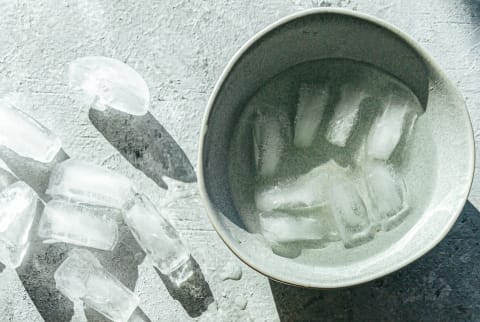What Happens When You Dunk Your Face In Ice Water? Here's A How-To


If you're prone to the afternoon slump, you might also be a 4 p.m. coffee drinker. While there's nothing wrong with an afternoon cup of joe, you may want to find another energy-boosting habit, especially if the extra caffeine keeps you up at night.
One underrated pick-me-up: cold exposure. This method has been around forever but recently picked up on TikTok via the viral ice bowl method. However, there are a few different ways to go about it—and some are easier than others, so let's dive in (pun intended).
What happens when you dunk your face in ice water?
Placing your face, or your body in general, into a bowl or tub of ice water can directly impact your mood. That slightly panicked feeling you get comes from the activation of the stress response, or sympathetic nervous system, as clinical psychologist Aric Prather, Ph.D., explains on a recent episode of the mindbodygreen podcast. "Cold exposure can be alerting," he notes.
And by activating the sympathetic nervous system, you can also reduce in-the-moment anxiety. "Cold water immersion for the face is one of the best ways to tone that vagus nerve and allow your nervous system to have that type of resilience," exercise physiologist, personal trainer, and New York Times bestselling author Ben Greenfield says in another mindbodygreen podcast episode. "When your vagus nerve becomes toned, it's able to more effectively communicate with the rest of the organs—the heart, the lungs, the diaphragm, the brain—and it also is able to respond to stress in a far more refined way."
Not to mention, ice has anti-inflammatory properties when applied topically1, which is why so many people opt for facial icing to de-puff the skin and soothe painful breakouts. But it's not only ice water that's available for this purpose—you can also use ice globes in conjunction with facial massage for an even more beneficial ritual.
But let's say you're in the middle of a busy workday and don't exactly have the time (or the resources) to plunge your face into ice water—are there any other options? Luckily, the answer is yes: According to Prather, you can also stick your head in the freezer—and essentially reap similar benefits.
How to do it correctly.
Now, you don't want to place your face in freezing cold water for half an hour or get a brain freeze from chilling your face for too long—so here's how to do it correctly:
If you opt for the bowl method, then you'll want to start by filling up a large bowl with ice water. "The colder the water the better," Greenfield says. Stick your face in there for a few seconds but no more than 30, as you don't want to irritate the skin (and, well, you need to come up for air). If you need to take a break or two during your dip, that's totally fine too.
As mentioned above, you can also open the freezer and place your head in the chilly air for a few seconds. If you opt for this method, just be sure to avoid propping yourself up on any sort of stool (lest you stumble and fall) and stop the cold therapy immediately if you begin to feel a headache or any kind of discomfort. According to Prather, this simple method can "get through the doldrums of midafternoon without getting a cup of coffee."
The takeaway.
Cold therapy is just one way to fight off anxiety or an afternoon slump, sans caffeine. You can opt for the ice bowl method, place your head in the freezer, or go for a full-on ice bath, should you feel compelled. And the best part? This anxiety-slash-energy hack doesn't cost a dime.

Hannah Frye is the Assistant Beauty & Health Editor at mindbodygreen. She has a B.S. in journalism and a minor in women’s, gender, and queer studies from California Polytechnic State University, San Luis Obispo. Hannah has written across lifestyle sections including skin care, women’s health, mental health, sustainability, social media trends, and more. She previously interned for Almost 30, a top-rated health and wellness podcast. In her current role, Hannah reports on the latest beauty trends and innovations, women’s health research, brain health news, and plenty more.